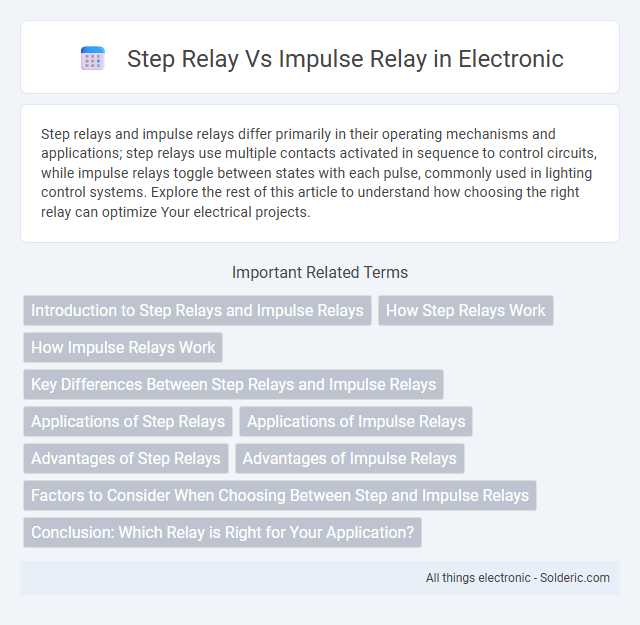Step relays and impulse relays differ primarily in their operating mechanisms and applications; step relays use multiple contacts activated in sequence to control circuits, while impulse relays toggle between states with each pulse, commonly used in lighting control systems. Explore the rest of this article to understand how choosing the right relay can optimize Your electrical projects.
Comparison Table
| Feature | Step Relay | Impulse Relay |
|---|---|---|
| Function | Multiple step switching via sequential inputs | Single pulse activates toggle switching |
| Operation | Changes state in a fixed sequence with each pulse | Switches ON/OFF state with each impulse |
| Common Applications | Lighting control, automation requiring multiple steps | Simple ON/OFF control in lighting and circuits |
| Contact Configuration | Multiple contacts for step-wise control | Single or double contacts for toggling |
| Power Consumption | Moderate, due to multiple coils or steps | Low, energy-efficient pulse operation |
| Control Input Type | Sequential pulses required | Single impulse signal |
| Advantages | Enables multi-step switching with less wiring | Simple, low power, reliable ON/OFF control |
Introduction to Step Relays and Impulse Relays
Step relays operate by sequentially advancing contacts each time an input pulse is received, making them ideal for controlling multi-step processes in industrial automation and lighting systems. Impulse relays, also known as latching relays, toggle their contacts between open and closed states with each received impulse, providing efficient control for staircase lighting and other applications requiring momentary switching. Both relay types offer distinct mechanisms for managing electrical circuits remotely while minimizing energy consumption and wear on mechanical components.
How Step Relays Work
Step relays operate by advancing their contacts through a sequence of predefined positions with each pulse received, allowing for multi-step switching in lighting or control circuits. These relays use a mechanical stepping mechanism or electronic controls to toggle between states, enabling complex automation tasks. Their ability to hold a position without continuous power makes them energy-efficient compared to impulse relays.
How Impulse Relays Work
Impulse relays operate by receiving a brief electric pulse that changes their contacts from one state to another, maintaining that position until the next pulse is received. Unlike step relays, which require multiple pulses for multiple steps, impulse relays toggle between open and closed states with each signal. Your electrical system benefits from impulse relays by enabling remote control of lights or circuits with minimal wiring and simple on/off switching.
Key Differences Between Step Relays and Impulse Relays
Step relays operate by advancing contacts mechanically through discrete steps with each input pulse, allowing multiple switching positions, whereas impulse relays toggle between ON and OFF states with each control pulse. Step relays are ideal for applications requiring sequential control of multiple circuits, while impulse relays excel in simple ON/OFF switching for lighting systems or remote controls. Your choice depends on the complexity of switching needs and whether multiple stable positions or binary control is required.
Applications of Step Relays
Step relays are widely used in electrical installations for controlling lighting circuits, stairwell lighting, and multi-location control systems where multiple push buttons operate a single light or group of lights. Their ability to maintain a stable state after each impulse makes them ideal for applications requiring step-wise switching without the need for continuous power consumption. Your choice of a step relay enhances energy efficiency and simplifies wiring in complex control environments.
Applications of Impulse Relays
Impulse relays are widely used in lighting control systems, enabling multiple switches to control a single light source efficiently. Common applications include stairway lighting, corridor lighting in hotels, and industrial automation where remote control of electrical circuits is required. Your electrical setup benefits from impulse relays by offering compact, reliable switching without the need for complex wiring.
Advantages of Step Relays
Step relays offer significant advantages in electric circuit control due to their ability to maintain multiple stable positions without continuous power consumption. These relays provide reliable, noise-free switching ideal for multi-position control applications, enhancing overall system efficiency and longevity. Your automation setup benefits from simplified wiring and reduced operational costs by using step relays over impulse relays.
Advantages of Impulse Relays
Impulse relays offer advantages such as reduced wiring complexity and enhanced durability due to their ability to switch circuits with brief control pulses, minimizing wear on mechanical components. They provide simplified control in multi-location lighting systems and can handle multiple switching commands efficiently, optimizing your electrical setup. These features make impulse relays an energy-saving and cost-effective choice for modern automation applications.
Factors to Consider When Choosing Between Step and Impulse Relays
Choosing between step relays and impulse relays depends on factors such as the required switching speed, load capacity, and control complexity. Step relays offer precise position control and are suitable for applications needing multiple stable states, while impulse relays excel in simple on/off control with minimal wiring. Consider electrical endurance, mechanical durability, and compatibility with existing control systems to optimize performance and reliability.
Conclusion: Which Relay is Right for Your Application?
Step relays offer precise multi-step switching ideal for applications requiring incremental control, while impulse relays excel in simple on/off switching with energy efficiency due to their momentary coil activation. Your choice depends on the complexity of control needed and energy consumption priorities. For detailed multi-position control, a step relay is suitable, whereas impulse relays are better for straightforward switching tasks.
Step relay vs impulse relay Infographic

 solderic.com
solderic.com